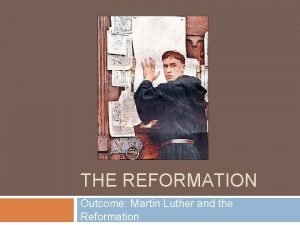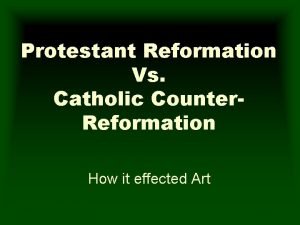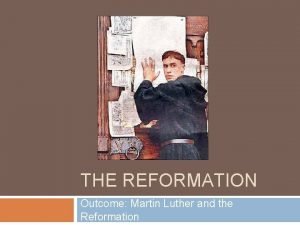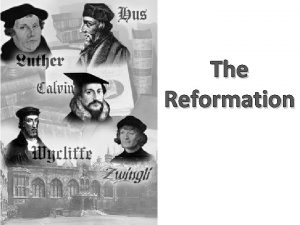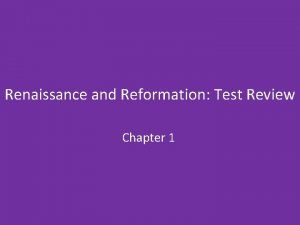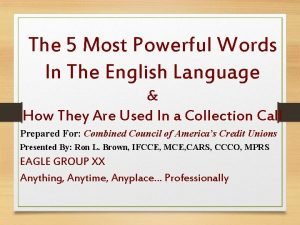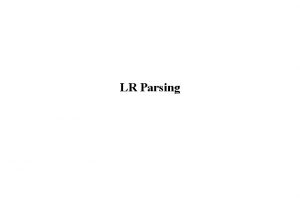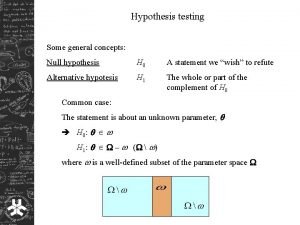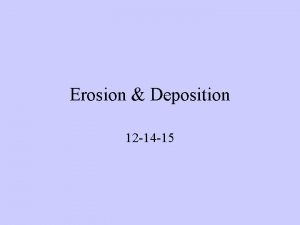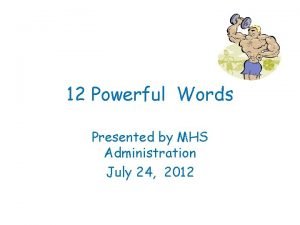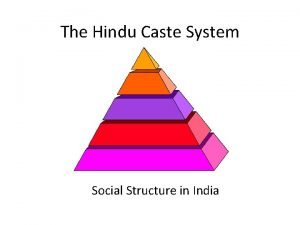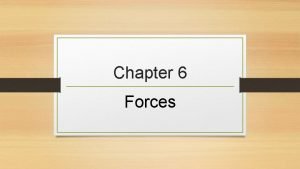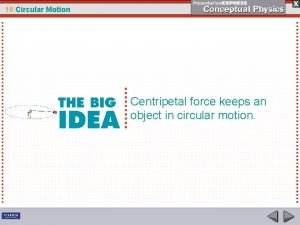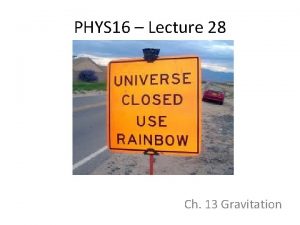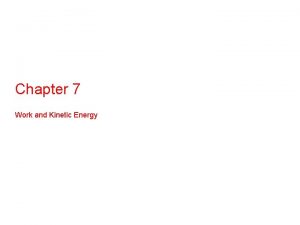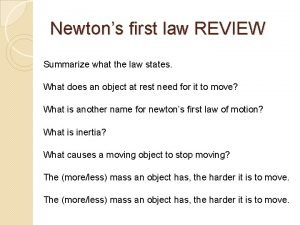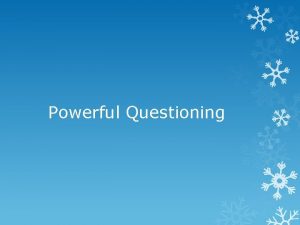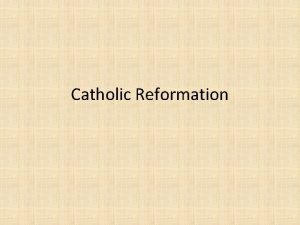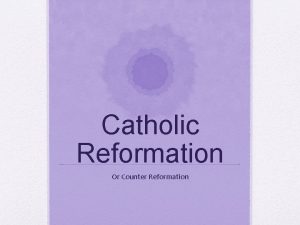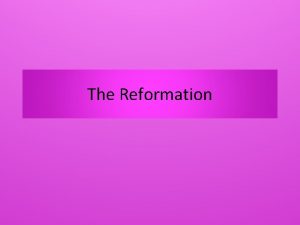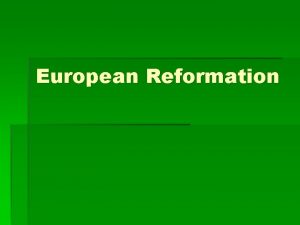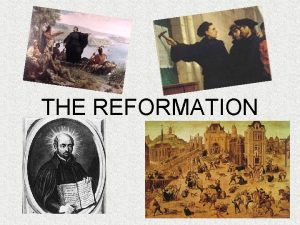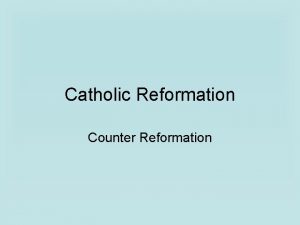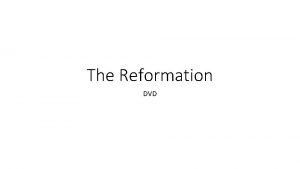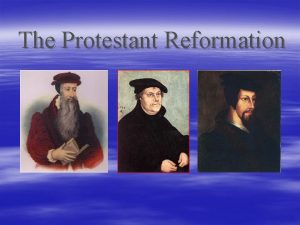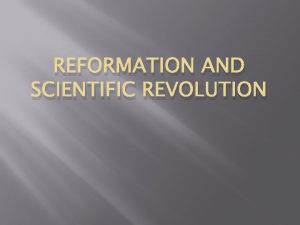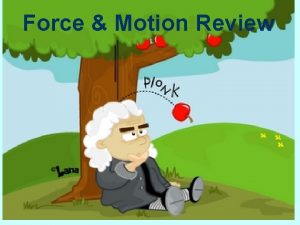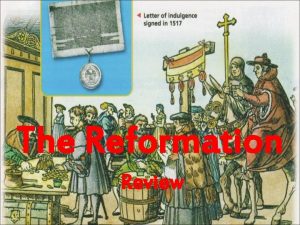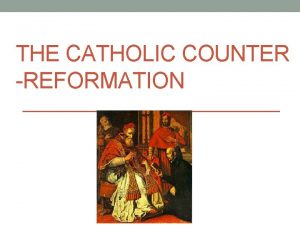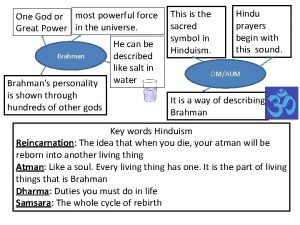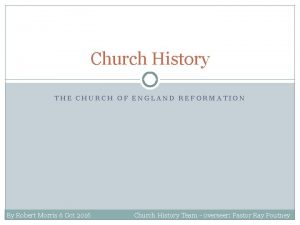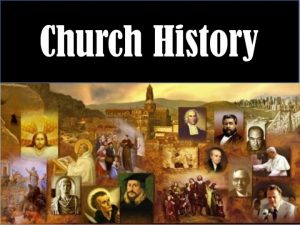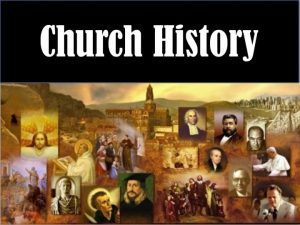Reformation Review The Church The most powerful force

































- Slides: 33

Reformation

Review- The Church • The most powerful force in Medieval Europe was the Roman Catholic Church. • The Church dominated everyday life, played a role in politics, and influenced kings by threatening excommunication • Popes competed with Italian princes for political power and fought wars to protect Papal states from invasions by secular rulers • No one dared question the Church’s authority for fear of being condemned to hell

Church Money • The Church made money in several ways: • Charging for baptisms, marriages and other sacraments • The 10% tithe (tax) • The selling of indulgences • The Church claimed to use the money to feed the poor and care for the sick. • However, the Church also spent large amounts of money to beautify churches throughout Europe Indulgence- a pardon for sins

Corruption in the Church • As the power and wealth of the Church grew, so did the corruption and worldliness of the Clergy • Large sums of money were spent on lavish homes, fancy clothes and large banquets. • Some members of the clergy were even frequently drunk and visited by prostitutes

Reformation • The secular ideas and humanism of the Renaissance caused people to question the Church’s authority and/or want to return to a simpler faith • Some Reformers spoke out against the church: • Erasmus • Martin Luther • John Calvin Martin Luther Erasmus

Erasmus • Dutch humanist who believed the Bible should be translated into vernacular of the people • Translated the New Testament into Greek and Latin • Wrote The Praise of Folly, a humorous expose of the church’s worldly practices and immoral behavior • Urged a return to simplicity of the early Christian Church- stressed study of the Bible

Martin Luther MOST IMPORTANTLY Martin Luther: Protestant Reformation Martin Luther King Jr. : American Civil Rights Movement

Martin Luther • Martin Luther was a German Monk from a middle class family • Joined a monastery after a near death experience, but suffered from doubts and believed he was a sinner doomed to eternal damnation • Became increasingly disillusioned with the corruption and worldliness that he saw in the Church • He was particularly offended by the selling of indulgences

The 95 Theses • October 1517 - German priest Johann Tetzel set up a pulpit (with the Pope’s permission) selling indulgences to anyone willing to contribute to the rebuilding of the Cathedral of St. Peter in Rome • These indulgences could not only spare the buyer, but all of their deceased relatives as well • On October 31, 1517 Martin Luther nailed 95 Theses (formal statements) criticizing indulgences and the corruption of the Church in general to the door of the Wittenberg Church • This marked the start of the Reformation

The 95 Theses • Luther’s 95 Theses have these main ideas: • All of the Church’s teachings should be based on the Bible • The Pope can’t free people from Purgatoryclergy have no special powers • Christians can only be saved through faith. The Bible does NOT offer indulgences as a way out of sin • The Bible needs to be the in vernacular so all people can read it and find a personal relationship with God. • According to Luther, true salvation can only truly be attained through repentance. Repentancesincere regret about one’s sin

Spreading Luther’s Ideas • Martin Luther’s ideas quickly spread due to the printing press. • Luther’s supporters quickly printed many copies of the Theses, and they were distributed throughout Europe. • The Church called on Luther to recant, but he refused- instead he urged Christians to reject the tyranny of Rome and wrote that the Church could only be reformed by secular authorities

The Pope Strikes Back • Pope Leo X (the Medici) excommunicated Luther in 1521 • Charles V, the Holy Roman Emperor, Dietheld a religious council called the assembly Diet of Worms • From this council/trial Luther’s teachings were found to be false, and he and his followers were declared heretics in the Edict of Worms • Luther still refused to give up his ideas, and Charles V declared him an outlaw, making it a crime for anyone in the empire to help him • However, Luther’s strong defense of his faith and ideas won many Europeans to his cause, and one of his followers allowed him to stay in his castle

Lutheranism • Despite being considered a heretic, Luther’s ideas gained a following due to the printing press and princes who wanted to lessen the power of the Church • Followers called themselves Lutherans, and adopted many of the changes Luther suggested, including: • Led services and used a Bible translated into the vernacular • Rejected 5 of the 7 sacraments because they weren’t mentioned in the Bible (and the Bible is the sole source of religious truth) • Emphasized the sermon and simplified the elaborate ritual of the mass • Banned indulgences, pilgrimages, and prayers to saints • Allowed the clergy to marry

Lutheranism=Protestantism • By 1530, Lutherans were using a new name, Protestant, for those who protested Papal authority and the Roman Catholic Church • Protestantism developed a large following in Northern Germany and Scandinavia among peasants who hoped that Luther would also support their plight for social and economic change • Protestants were persecuted by Roman Catholics, leading to a large revolt that was suppressed with great brutality, resulting in the loss of thousands of lives • Truce between Protestants and Catholics was reached under the Peace of Augsburg(1555), a treaty that allowed German princes to choose which religion would be followed in their territory

John Calvin • Luther’s success in revolting against the Church inspired others to challenge its authority as well • Most important was John Calvin, a Protestant from France who was trained as a priest and a lawyer • Calvin agreed with many of Luther’s ideas, but felt he had not gone far enough. • Agreed that salvation could only be achieved through faith and that the Bible was the only source of religious truth

Predestination • Calvin taught that God was allpowerful and that humans were sinful by nature • Put forth the idea of predestinationthat God had chosen long ago who would achieve Salvation • No one can know if they’re meant to be saved or not, so you must live a devout and religious life just in case. • If you are predetermined to go to Heaven but are not devout, you may be denied.

Calvin’s Geneva • Protestants in Geneva, Switzerland appreciated Calvin's views and asked him to lead their government. Calvin set up a theocracy and punished anyone who was not devout. • Geneva’s citizens created a truly Christian society and stressed hard work, discipline, thrift, honesty and morality. • Citizens faced fines or other punishment for offenses like fighting, swearing, laughing in church, or dancing. Theaters were closed and elaborate dress was prohibited Theocracy- government run by religious leaders

Protestantism Spreads • The use of the printing press allowed the ideas of Luther and John Calvin to spread quickly. • Protestants joined several sects (Lutheran, Anglican, Calvinist), but all were “protesting” against the corrupt Catholic church. • The Protestants controlled most of Northern Europe, while the Roman Catholics kept control of the West and South.

English Reformation • The English Reformation is led by King Henry VIII. • Unlike Luther and Calvin, King Henry wished to end the Pope’s control over the English Church. • He was not motivated by religious morality, but political reasons. • King Henry wanted the monarchy to be in charge of the church.

King Henry VIII • At first, King Henry was firmly against the Protestant Revolt. • King Henry VIII was married to Catherine of Aragon for 18 years, but only had one surviving daughter, Mary Tudor. • Henry wanted a son to succeed him to the throne (an example of a Dynasty). • Henry and Catherine married through the Catholic Church, which does not allow for divorce. So Henry asked the Pope to annul his marriage. • However, the Pope refused, as he did not want to upset the Holy Roman Emperor- Catherine’s nephew, Charles V Annul. Declare invalid or void; cancel

Henry VIII’s Reformation • Furious, Henry called a special meeting of Parliament and passed a series of laws that took the English Church from the Pope’s control and placed it under Henry’s rule. • He appointed an archbishop who agreed to annul his marriage to Catherine • Under the Act of Supremacy (1534) the English Monarch is established as the head of the English Church • Henry doesn’t make any changes to worship, just who is in charge

King Henry’s Six Wives • After divorcing Catherine of Aragon, Henry weds Anne Boleyn, Catherine's lady in waiting (maid) • Anne Boleyn becomes pregnant but the child is miscarried. She is unable to give him an heir so he charges her with adultery, and beheads her. • Henry’s next wife, Jane Seymour, provides him with an heir named Edward. Jane dies from complications with the birth and Henry mourns for three years. • He next marries Anne von Cleves from Germany, but finds her unattractive and divorces her. • Then he marries the very young Catherine Howard, who began cheating on him. Catherine was beheaded for her crimes. • Henry’s last wife was Catherine Parr, and after attempting to ban all books, she was kept under close watch.

The Church of England • The Church of England is renamed the Anglican Church • Between 1536 -1540, Henry ordered all convents and monasteries to close and seized their lands and wealth for the crown • Henry granted some of the church’s lands to high-ranking nobles and officials, securing their support for the Anglican Church • Not interested in Protestant Doctrinesaside from breaking away from Rome and allowing use of the English Bible, Henry kept most Catholic forms of worship

Religious Turmoil • After Henry VIII dies, his son Edward I takes the throne. Edward is only 10, and relies on the advice of his father’s many advisors. • These advisors tell Edward to push for more Protestant reforms, which angers the Catholicleaning English people. • When Edward dies at 16, England is in religious turmoil. • Mary Tudor, daughter of Henry’s first wife, takes the throne after his death • A devout Catholic, she was determined to make England Catholic again and began persecuting Protestants. This made her terribly unpopular, and she feared she would lose throne.

Elizabeth I • Elizabeth was Mary’s half sister, and was locked away for many years due to Mary’s paranoia. • When Mary died, Elizabeth took over the throne. She was a very skilled leader and created a religious compromise between the Catholics and Protestants. • Adopted English for Anglican ceremonies • Allowed the clergy to keep fancy robes • Kept the Book of Common prayer, with prayers and rules for Anglicans (but was revised to be more acceptable for Catholics) • Despite the compromises, Elizabeth kept the monarch at the head of the Anglican Church.

Catholic Reform • Concerned about the number of converts from Catholicism to Protestantism, Pope Paul III began reform within the Catholic church • He organized the Council of Trent (15451565) to establish Catholic practices and reforms: 1) Salvation through faith AND good deeds 2) Bible is one but not the ONLY source of religious truth 3) Began punishing corrupt and worldly clergy

The Inquisition • To deal more directly with the threat of Protestantism, Pope Paul strengthened the Inquisition • The Inquisition was a Church court system established in the Middle Ages • Used secret testimony, torture, and execution to root out heretics, and developed a list of works considered too immoral for Catholics to read • Resulted in a number of new torture methods and witch hunts

Witch Hunts • Religious fervor of the time led to a wave a witch hunting • From 1450 -1750, tens of thousands of women and men (mostly women) died as victims of witch hunts • “In troubled times, people looked for scapegoats. Typically, people accused of witchcraft were social outcasts— beggars, poor widows, midwives blamed for infant deaths, or herbalists whose potions and cures were seen as gifts of the devil. ”

The Jesuits • Ignatius of Loyola, a Spanish Knight, founded a new religious order called the Society of Jesus, or Jesuits, dedicated to combating heresy and spreading the Catholic faith • Jesuits had to follow a strict program of discipline, undergo intense training, and be completely obedient to the church. • They travelled throughout Europe pushing Catholic reform and converting Christians back to Catholicism

Teresa of Avila • Teresa was the daughter of rich merchants. She joined a convent of nuns at a young age, but was disappointed by the lack of order and religious devotion. • Teresa founded her own convent, stressing prayer and religious duty over all else. The nuns in her new convent ate little and rarely slept, dedicating themselves to prayer and meditation. • As news of her strict convent spread, the Catholic church asked her to reform other convents and monasteries. • After her death, Teresa was canonized, and her writings are regarded as some of the most significant Christian texts of her time.

Results of the Catholic Reformation • The Catholic reformation had several important results: • Stopped the rapid spread of the Protestant Religion • Returned the church to devout piety • Europe remained divided between Protestants in the North and Catholics in the South • Hundreds of thousands were killed by inquisition, religious attacks and witch hunts. New Protestant sects: • Anglican • Calvinists • Lutherans

Persecution of Jews • Religious turmoil brought an increase in persecution of European Jews • Jews were pressured to convert to Christian religions • Forced to live in ghettos- separate quarters of cities (both in Italy and Germany) • Germans required Jews to wear a yellow badge if they travelled outside of the ghetto • Luther had hoped Jews would convert to his teachings, but when they didn’t, he called for them to be expelled from Christian lands and their synagogues destroyed

Causes and Effects Long-term Causes Immediate effects Long-term effects Roman Catholic Church becomes more worldly The selling of indulgences causes Martin Luther to post the 95 Theses Founding of Lutheran, Calvinist, Anglican, Presbyterian and other Protestant Churches Roman Catholic Churches launch reforms Printing press spreads the 95 Theses and the German language Bible Protestant Reformation Time of change and questioning the Roman Catholic Church Inquisition tracks down heresies
 The reformation outcome: martin luther and the reformation
The reformation outcome: martin luther and the reformation Protestant reformation vs counter reformation
Protestant reformation vs counter reformation The reformation outcome martin luther and the reformation
The reformation outcome martin luther and the reformation What were the final decrees of the council of trent
What were the final decrees of the council of trent Corruption in the church during the reformation
Corruption in the church during the reformation The renaissance and reformation test
The renaissance and reformation test 5 powerful words
5 powerful words Most powerful test
Most powerful test The most powerful parser is
The most powerful parser is Hypothesis example
Hypothesis example What is the most common and powerful agent of erosion?
What is the most common and powerful agent of erosion? 12 powerful words
12 powerful words The most powerful daily from
The most powerful daily from The caste system
The caste system Most powerful sans
Most powerful sans Contact vs non contact forces
Contact vs non contact forces Vt=2pir/t
Vt=2pir/t Long range force
Long range force What force provides centripetal force
What force provides centripetal force How does mechanical advantage work
How does mechanical advantage work Net force
Net force Centripetal force culture
Centripetal force culture Non contact force
Non contact force Why electric field is conservative
Why electric field is conservative Centripetal force and gravitational force
Centripetal force and gravitational force Hooke's law vector form
Hooke's law vector form Internal force examples
Internal force examples Mustafa sheikh lawyer review
Mustafa sheikh lawyer review Chapter review motion part a vocabulary review answer key
Chapter review motion part a vocabulary review answer key Ap gov review final exam review
Ap gov review final exam review Nader amin-salehi
Nader amin-salehi Systematic review definition
Systematic review definition Narrative review vs systematic review
Narrative review vs systematic review How companies react to the marketing environment
How companies react to the marketing environment
